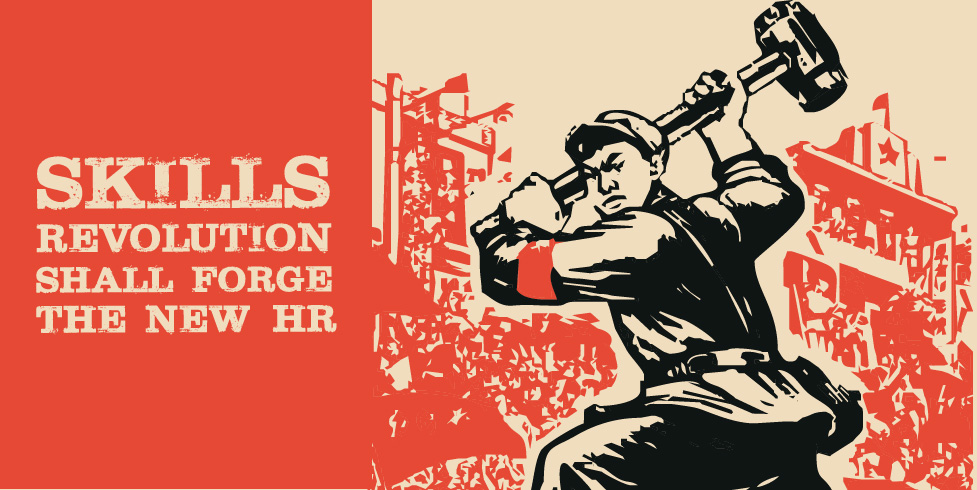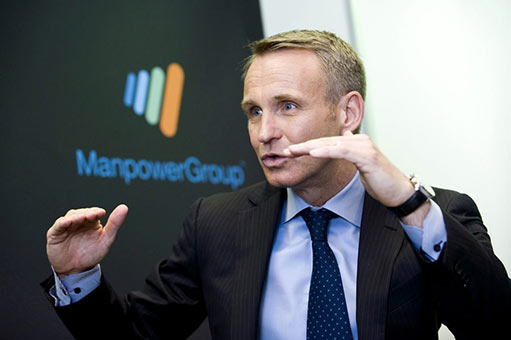
Structural changes within organisations and the entire economy, like aging demographics and digitisation, have placed a huge demand on skilled talent in order to leverage ever more productive modes of work. Jonas Prising, Chairman and CEO, ManpowerGroup believes that a skills revolution is now necessary to meet this demand which will, in turn, require organisations to completely re-imagine the way they think about human capital, employment and HR functions. HR Magazine interviewed Prising at the ManpowerGroup Greater China Summer Summit held on 16 August in Shenzhen and we share his take on why HR needs to continually upskill talent to thrive in the skills revolution.
Future of work bright— with the right skills
In contrast to the usual concerns about digitisation destroying jobs, Prising argued that the future for employment looks incredibly bright. In fact, a recent survey by ManpowerGroup of 18,000 employers globally indicated that over 83% of organisations would maintain or increase their headcount over the coming years as a result of greater automation. The research further found most employers in China expect automation will bring a net gain for employment. The majority expect to maintain or increase their headcount and upskill their people. This is echoed in latest research conducted by Robert Half which found that 72% of Hong Kong CFOs agreed workplace automation would not cause a loss of jobs, but that a shift in required skillsets was needed. The challenge as Prising sees it is not that jobs will be destroyed, but rather the nature of jobs will evolve and continue to change in the future.
Thus the focus of the Skills Revolution is in ensuring that individuals are given the training, support and opportunities they need to develop and adapt to the world of tomorrow. Prising cautioned HR, “The biggest risk is the temptation to think about this as a cyclical change that will eventually go away. This is no short-term project, but rather a necessary paradigm shift in the way that HR professionals view training and upskilling as part of their overall offering.”

Jonas Prising, Chairman and CEO, ManpowerGroup
The notion of learnability—an individual’s desire and ability to learn new skills—will be one of most important things that HR leaders need to cultivate in the future. Rather than seeing skills growth as a medium-term one or two year investment, Prising noted, “HR’s ability to upskill in an environment that is more global, more dynamic, more volatile and where technology is starting to shift the way work gets done is a long-term process.” Estimates by McKinsey suggested that 65% of the jobs that Generation Z will perform do not even exist yet, further highlighting this need for organisations to shift their HR culture into one where skills are constantly developed in a far-sighted manner.
Prising commented that no matter what objectives a business has, success will depend on the proper deployment of human resources and acquisition of skills. Therefore, for individuals in HR the true measure of success during this culture shift will lie in the number of individuals who are able to bridge the gap between today and tomorrow. He explained, “While the magnitude and scope of change required can be daunting for organisations, and the pace of change is certainly picking up compared to what it was before, it won’t have to happen overnight. The most important thing is that organisations make a concerted, deliberate and purposeful effort to make the transition.”
There is a mosaic of ways in which employees can engage with employers and employment.
Skills-based employer-employee relationships
One effect of the increased demand for skills is that the traditional way of thinking about the employer-employee relationship is being challenged. Prising said, “There is a mosaic of ways in which employees can engage with employers and employment and this is a rational response to a world that increasingly demands higher skills. In the past employees had a job for life (where there was little movement between companies) or a job for now (where a job was held for decades rather than for a lifetime), increasingly nowadays employees are now looking for a so called ‘career for me’.” He added, “Individuals are recognising that job security has shifted away from the traditional pay, benefits and a company pension offered by old work models, and are focusing on staying competitive and relevant in the job market. Career growth is no longer driven by company loyalty or experience, but rather by the skills that an employee can bring to organisations.”
Thus, career hungry employees are more likely than ever to put a premium on their own development. This has manifested in the attitudes that Millennials hold towards their jobs, being more willing to take on additional responsibility and more likely to leave if stretch opportunities do not present themselves.
In the past, graduate employees typically changed jobs around twice in the first decade after leaving university, nowadays they will change employers around four times over the same period.
Contentious candidates
Research by ManpowerGroup found that 57% of Millennials recognised that in order for their careers to progress, their skills also need to develop. Over a quarter also said that the key to having job security in the future lay in gaining marketable skills—highlighting the importance that Millennials place on development. This shift in ethos has led ManpowerGroup to define a full third of present day workers as ‘contentious candidates’, who are driven to advance their career and update their skills by changing jobs frequently.
As a result, individuals will increasingly seek out a mixture of full-time, part-time and freelance work throughout their working lives as they prioritise maximising the skills and experiences they need to grow. This is reflected in data gathered by both Princeton and Harvard Universities in The Rise and Nature of Alternative Work Arrangements in the United States, which suggests that the number of employees in alternate work arrangements in the US (including independent contract arrangements, on call and temporary work) has risen from 10.7% to 15.8% in the past 10 years. This trend is set to continue. The recent report Millennial Careers: 2020 Vision highlights that half of all Millennials would be willing to work in a non-traditional employment arrangement in the future.
Employers will have to have a clear value proposition.
Developing in-house talent safest way of securing skills
While it might be tempting for HR leaders to respond to the increasing flexibility of employees by doubling down on a spot hire strategy, where skilled talent is found on an as needs basis, Prising believed this approach was short sighted. He noted, “One of the main drivers of talent shortage is an aging demographic, so it’s going to be much harder to find individuals just based on the available talent pool.” He added, “Since organisations on a global level will be competing for the same, increasing footloose talent only—relying on the spot market to find the talent that you need to execute your business strategy—is a very risky choice.”
Prising instead argued that farsighted companies will not only develop skills and talent through their own internal pipelines, but that they will use those pipelines as a means of attracting and holding onto external talent. If an employer can shift their value proposition for employees to one that offers skills and growth, they are better able to tap into that recognition and secure a strong pool of talent to recruit from. He summarised, “Employers will have to have a clear value proposition that says ‘look we understand that you’re not going to work for us for 40 years and in actual fact we understand that we can’t make that promise to you either. So a fair trade is that when you come to us and spend time here we will guarantee you that we will continue to evolve your skills—that’s why you should join us’.”
Demand for this kind of development offers great opportunities for HR professionals. While SMEs might not have the resources or expertise to provide these shifts in HR culture internally, the increasing demand for highly skilled labour will create spaces in the market for HR providers who are able to provide a strong, steady pipeline of flexible but skilled talent which is ready for deployment in SMEs.
Women to benefit from changing approaches to work
Just as employers better attract skilled Millennial talent by re-thinking their value proposition, employers also have the opportunity to improve their attractiveness to skilled female talent. With women generally holding higher levels of education, but participating between 25 – 35% less in the workforce than men, Prising says that one of the fastest ways to catalyse organisational growth is to better include women, and the skills they hold, in the workforce.
Prising predicted, “Organisations that are able to make accommodations for women by offering flexible working arrangements— giving them more time to develop skills and/or look after their families—are going to disproportionately be able to attract and retain women in the future.” Additionally, such arrangements offer benefits to employers beyond securing skills; in some contexts flexible working may allow for improvements in productivity. For example, work done predominantly on the computer does not require physical presence if the work is done on the Cloud. Prising theorised that as measurement of things like actual output become more precise and accurate, such benefits will be obvious.
Flexible employment is the future
Employers can also respond to the shift in employee values by broadening their conception of the way that work gets done. Prising said, “Relying solely on traditional employees in static offices is no longer the only way to complete tasks: crowdsourcing, offshoring and the use of virtual teams are examples of opportunities that can flatten organisations and improve agility. Instead of trying to predict the future, being responsive is much more important.”
A case study of this in action can be seen in the employment patterns in China. In the late 20th century, many Chinese workers were relatively low skilled and on low incomes, producing products at an incredibly low cost. The emphasis for employers was on getting large numbers of workers physically into their factories to keep their industrial concerns expanding.
Nowadays, China’s industry is becoming one of the world’s largest consumers of AI and robotics, as manufacturers seeks to expand their offering to become competitive in terms of quality, not just price. Such a transformation requires higher skills but fewer hands on the factory floor, and a swathe of additional employees to support this tech-focused way of producing goods—forging a new HR. In the new era, HR managers throughout China are completely rethinking the shape of their organisations and how they utilise their employees. Prising cited a typical example, “If a factory produces goods that are sold worldwide, offshoring sales functions or integrating overseas employees with virtual design teams might be appropriate, and give the company greater flexibility in case geo-political winds change direction.”
Get close to the business and truly understand what levers within the business make it more or less successful.
HR must be commercially focussed
The importance of HR in meeting the challenges of the skills revolution cannot be understated. Prising highlighted, “The importance of HR leaders will be much greater tomorrow than it was today because access to skilled talent pools will determine the success of the organisation that they work for and for whom they recruit.” He added, “And as organisations must adapt to the changing business landscape, so too must HR. Perspectives need to shift from the transactional and tactical to become more business focused and strategic. A hire and fire mentality, while working beautifully for the past 30 years, is an inadequate mindset for providing real success in the future.”
Increasingly, individuals are coming from outside of HR into the profession. According to the recent report Developing the Next Generation of CHROs in Southeast Asia by Aon, almost 40% of CHRO’s emanate from a non-HR background. Such a background invariably gives these individuals a broader practical understanding of how organisations make money and what HR functions can best drive performance within that context. From a C-suite perspective, placing such talent within HR makes perfect sense. Prising noted, “If access to skilled talent is the key to the future success of the company, CEOs are going to make sure that they have individuals running those functions that help them achieve that very objective.” He advised, “Current HR leaders must get close to the business and truly understand what levers within the business make it more or less successful. Existing transactional functions within the HR industry will be significantly technology driven, if not automated, within the next decade.” Such change is yet another reason for HR to evolve to become closer to the commercial side of organisations.
The traditional ways in which HR measures success can also be re-designed to better reflect changing attitudes. With employees more likely to pursue opportunities elsewhere, markers such as attrition will become less important. Prising commented that other tools, such as an employee net-promoter score that tries to gauge the mood of the workforce more responsively, are more effective because they give an up to date snapshot of how employees are feeling. This means HR managers can then be pro-active in responding to shifting moods within the workplace instead of acting after an employee leaves, as is the case with attrition. Prising advised that HR departments look into redeveloping feedback tools so that data gathered can be acted upon in a shorter time frame—replacing an annual review with a pulse review that happens monthly, or improving the frequency and quality of manager-employee interaction.
Policy changes coming
The demand for skills and changing way that we work poses challenges for policy makers as well as HR professionals. Prising suggested that the way that labour legislation is written across the globe is increasingly unfit for the future of work. He said, “Most of the labour legislation in Europe is built around the notion of job security, as opposed to a notion of employment security. Instead of simply protecting an employee’s right to stay in a job, I predict that legislation in the future will increasingly offer skills development and the opportunity to compete within the breadth of the job market.” He cited examples of the UK Government’s review of the gig economy and France’s proposed notion of Flexicurity as ways in which modern governments are responding to this need. He added, “A modified system requires flexibility combined with security, whether that is providing individuals with subsidies for training, or providing additional mechanisms to help employees transition from one employer to another.” He concluded “No matter what the industry, or location in the world, securing and developing skills is going to be the defining challenge of our time.”
The skills revolution: 3 questions every HR leader must ask
As a practical response to such workplace volatility, Prising puts forward three questions that HR leaders must consider:
- What are my future talent sources? Assess the strengths of your current pipeline and look for any un-accessed talent pools to provide additional skills or experience.
- What work models are best suited for my organisation and its business strategies? Evaluate the way that your current employees do work and see if they can perform their roles more effectively through alternative arrangements.
- What are the people practices I will use? Determine how to increase your value and exploit institutional strengths to leverage interest from prospective employees.






